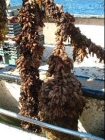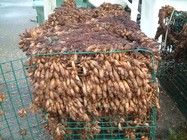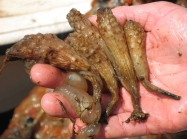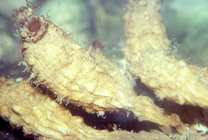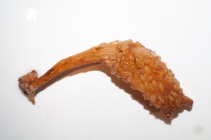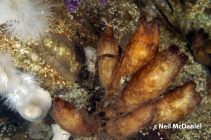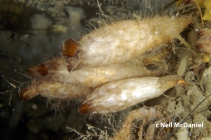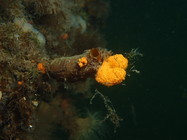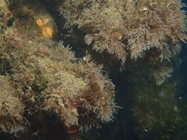Scheldt species taxon details
Styela clava Herdman, 1881
103929 (urn:lsid:marinespecies.org:taxname:103929)
accepted
Species
marine, fresh, terrestrial
Herdman, W. A. (1881). Preliminary report on the Tunicata of the Challenger expedition. Cynthiidae. <em>Proceeding of the Royal Society of Edinburgh.</em> 11(3): 52-88., available online at https://www.biodiversitylibrary.org/page/48710941
page(s): 63, 70 [details]
page(s): 63, 70 [details]
Shenkar, N.; Gittenberger, A.; Lambert, G.; Rius, M.; Moreira da Rocha, R.; Swalla, B.J.; Turon, X. (2021). Ascidiacea World Database. Styela clava Herdman, 1881. Accessed through: VLIZ Consortium Scheldt Species Register at: https://www.scheldemonitor.org/speciesregister/aphia.php?p=taxdetails&id=103929 on 2025-09-11
VLIZ Consortium. Scheldt Species Register. Styela clava Herdman, 1881. Accessed at: https://scheldemonitor.nl/speciesregister/aphia.php?p=taxdetails&id=103929 on 2025-09-11
Date
action
by
original description
Herdman, W. A. (1881). Preliminary report on the Tunicata of the Challenger expedition. Cynthiidae. <em>Proceeding of the Royal Society of Edinburgh.</em> 11(3): 52-88., available online at https://www.biodiversitylibrary.org/page/48710941
page(s): 63, 70 [details]
context source (Introduced species) Katsanevakis, S.; Bogucarskis, K.; Gatto, F.; Vandekerkhove, J.; Deriu, I.; Cardoso A.S. (2012). Building the European Alien Species Information Network (EASIN): a novel approach for the exploration of distributed alien species data. <em>BioInvasions Records.</em> 1: 235-245., available online at http://easin.jrc.ec.europa.eu [details] Available for editors
context source (Deepsea) Intergovernmental Oceanographic Commission (IOC) of UNESCO. The Ocean Biogeographic Information System (OBIS), available online at http://www.iobis.org/ [details]
context source (HKRMS) Morton, B. & Morton, J. (1983). <i>The sea shore ecology of Hong Kong</i>. Hong Kong: Hong Kong University Press. 350 pp. [details]
context source (Schelde) (2010). Bedreiging voor biodiversiteit. Indicatoren voor het Schelde-estuarium. <em>Opgemaakt in opdracht van Afdeling Maritieme Toegang, projectgroep EcoWaMorSe, Vlaams Nederlandse Scheldecommissie. VLIZ Information Sheets, 200. Vlaams Instituut voor de Zee (VLIZ): Oostende.</em> 7 pp. (look up in IMIS) [details]
basis of record Monniot, C. (2001). Ascidiacea & Sorberacea. <em>In: Costello, M.J. et al. (Ed.) (2001). European register of marine species: a check-list of the marine species in Europe and a bibliography of guides to their identification. Collection Patrimoines Naturels.</em> 50: pp. 352-355. (look up in IMIS) [details]
additional source Millar, R. H. (1975). Ascidians from the Indo-West-Pacific region in the zoological museum, Copenhagen (Tunicata, Ascidiacea). <em>Steenstrupia.</em> 3(20): 205-336. (look up in IMIS)
page(s): 302, Fig. 81. [details] Available for editors
additional source Muller, Y. (2004). Faune et flore du littoral du Nord, du Pas-de-Calais et de la Belgique: inventaire. [Coastal fauna and flora of the Nord, Pas-de-Calais and Belgium: inventory]. <em>Commission Régionale de Biologie Région Nord Pas-de-Calais: France.</em> 307 pp., available online at http://www.vliz.be/imisdocs/publications/145561.pdf [details]
additional source Streftaris, N., A. Zenetos & E. Papathanassiou. (2005). Globalisation in marine ecosystems: the story of non-indigenous marine species across European seas. <em>Oceanogry and Marine Biology: an Annual Review.</em> 43: 419-453. (look up in IMIS) [details] Available for editors
additional source Kott, P. (1985). The Australian Ascidiacea part 1, Phlebobranchia and Stolidobranchia. <em>Mem Qd Mus.</em> 23: 1-440., available online at http://biostor.org/reference/109626 [details] Available for editors
additional source Kott, P.; Bradford-Grieve, J.; Esnal, G.; Murdoch, R.C. (2009). Phylum Tunicata: sea squirts, salps, appendicularians, in: Gordon, D.P. (Ed.) (2009). New Zealand inventory of biodiversity: 1. Kingdom Animalia: Radiata, Lophotrochozoa, Deuterostomia. pp. 409-430. [details] Available for editors
additional source Liu, J.Y. [Ruiyu] (ed.). (2008). Checklist of marine biota of China seas. <em>China Science Press.</em> 1267 pp. (look up in IMIS) [details] Available for editors
additional source Zenetos, A., S. Gofas, M. Verlaque, M. Cinar, J. Garcia Raso, C. Bianchi, C. Morri, E. Azzurro, M. Bilecenoglu, C. Froglia, I. Siokou, D. Violanti, A. Sfriso, G. San Martin, A. Giangrande, T. Katagan, E. Ballesteros, A. Ramos-Espla, F. Mastrototaro, O. Ocana, A. Zingone, M,. Gambi & N. Streftaris. (2010). Alien species in the Mediterranean Sea by 2010. A contribution to the application of European Union's Marine Strategy Framework Directive (MSFD). Part I. Spatial distribution. <em>Mediterranean Marine Science.</em> 11(2): 381-493., available online at https://doi.org/10.12681/mms.87 [details]
additional source Izquierdo-Muñoz, A.; Díaz-Valdés, M.; Ramos-Esplá, A.A. (2009). Recent non-indigenous ascidians in the Mediterranean Sea. <em>Aquatic Invasions.</em> 4(1): 59-64., available online at http://www.aquaticinvasions.net/2009/AI_2009_4_1_IzquierdoMunoz_etal.pdf [details]
additional source Zenetos, A., E. Meric, M. Verlaque, P. Galli, C.F. Boudouresque, A. Giangrande, M. Cinar & M. Bilecenoglu. (2008). Additions to the annotated list of marine alien biota in the Mediterranean with special emphasis on Foraminifera and Parasites. <em>Mediterranean Marine Science.</em> 9(1): 119-165., available online at https://doi.org/10.12681/mms.146 [details] Available for editors
additional source Hillock, K. A.; Costello, M. J. (2013). Tolerance of the invasive tunicate Styela clava to air exposure. <em>Biofouling.</em> 29(10): 1181-1187., available online at https://doi.org/10.1080/08927014.2013.832221 [details] Available for editors
additional source Howson, C.M. & B.E. Picton. (1997). The species directory of the marine fauna and flora of the British Isles and surrounding seas. <em>Ulster Museum Publication, 276. The Ulster Museum: Belfast, UK. ISBN 0-948150-06-8.</em> vi, 508 (+ cd-rom) pp. (look up in IMIS) [details] Available for editors
additional source van der Land, J. (ed). (2008). UNESCO-IOC Register of Marine Organisms (URMO). , available online at http://www.marinespecies.org/urmo/ [details]
page(s): 63, 70 [details]
context source (Introduced species) Katsanevakis, S.; Bogucarskis, K.; Gatto, F.; Vandekerkhove, J.; Deriu, I.; Cardoso A.S. (2012). Building the European Alien Species Information Network (EASIN): a novel approach for the exploration of distributed alien species data. <em>BioInvasions Records.</em> 1: 235-245., available online at http://easin.jrc.ec.europa.eu [details] Available for editors
context source (Deepsea) Intergovernmental Oceanographic Commission (IOC) of UNESCO. The Ocean Biogeographic Information System (OBIS), available online at http://www.iobis.org/ [details]
context source (HKRMS) Morton, B. & Morton, J. (1983). <i>The sea shore ecology of Hong Kong</i>. Hong Kong: Hong Kong University Press. 350 pp. [details]
context source (Schelde) (2010). Bedreiging voor biodiversiteit. Indicatoren voor het Schelde-estuarium. <em>Opgemaakt in opdracht van Afdeling Maritieme Toegang, projectgroep EcoWaMorSe, Vlaams Nederlandse Scheldecommissie. VLIZ Information Sheets, 200. Vlaams Instituut voor de Zee (VLIZ): Oostende.</em> 7 pp. (look up in IMIS) [details]
basis of record Monniot, C. (2001). Ascidiacea & Sorberacea. <em>In: Costello, M.J. et al. (Ed.) (2001). European register of marine species: a check-list of the marine species in Europe and a bibliography of guides to their identification. Collection Patrimoines Naturels.</em> 50: pp. 352-355. (look up in IMIS) [details]
additional source Millar, R. H. (1975). Ascidians from the Indo-West-Pacific region in the zoological museum, Copenhagen (Tunicata, Ascidiacea). <em>Steenstrupia.</em> 3(20): 205-336. (look up in IMIS)
page(s): 302, Fig. 81. [details] Available for editors
additional source Muller, Y. (2004). Faune et flore du littoral du Nord, du Pas-de-Calais et de la Belgique: inventaire. [Coastal fauna and flora of the Nord, Pas-de-Calais and Belgium: inventory]. <em>Commission Régionale de Biologie Région Nord Pas-de-Calais: France.</em> 307 pp., available online at http://www.vliz.be/imisdocs/publications/145561.pdf [details]
additional source Streftaris, N., A. Zenetos & E. Papathanassiou. (2005). Globalisation in marine ecosystems: the story of non-indigenous marine species across European seas. <em>Oceanogry and Marine Biology: an Annual Review.</em> 43: 419-453. (look up in IMIS) [details] Available for editors
additional source Kott, P. (1985). The Australian Ascidiacea part 1, Phlebobranchia and Stolidobranchia. <em>Mem Qd Mus.</em> 23: 1-440., available online at http://biostor.org/reference/109626 [details] Available for editors
additional source Kott, P.; Bradford-Grieve, J.; Esnal, G.; Murdoch, R.C. (2009). Phylum Tunicata: sea squirts, salps, appendicularians, in: Gordon, D.P. (Ed.) (2009). New Zealand inventory of biodiversity: 1. Kingdom Animalia: Radiata, Lophotrochozoa, Deuterostomia. pp. 409-430. [details] Available for editors
additional source Liu, J.Y. [Ruiyu] (ed.). (2008). Checklist of marine biota of China seas. <em>China Science Press.</em> 1267 pp. (look up in IMIS) [details] Available for editors
additional source Zenetos, A., S. Gofas, M. Verlaque, M. Cinar, J. Garcia Raso, C. Bianchi, C. Morri, E. Azzurro, M. Bilecenoglu, C. Froglia, I. Siokou, D. Violanti, A. Sfriso, G. San Martin, A. Giangrande, T. Katagan, E. Ballesteros, A. Ramos-Espla, F. Mastrototaro, O. Ocana, A. Zingone, M,. Gambi & N. Streftaris. (2010). Alien species in the Mediterranean Sea by 2010. A contribution to the application of European Union's Marine Strategy Framework Directive (MSFD). Part I. Spatial distribution. <em>Mediterranean Marine Science.</em> 11(2): 381-493., available online at https://doi.org/10.12681/mms.87 [details]
additional source Izquierdo-Muñoz, A.; Díaz-Valdés, M.; Ramos-Esplá, A.A. (2009). Recent non-indigenous ascidians in the Mediterranean Sea. <em>Aquatic Invasions.</em> 4(1): 59-64., available online at http://www.aquaticinvasions.net/2009/AI_2009_4_1_IzquierdoMunoz_etal.pdf [details]
additional source Zenetos, A., E. Meric, M. Verlaque, P. Galli, C.F. Boudouresque, A. Giangrande, M. Cinar & M. Bilecenoglu. (2008). Additions to the annotated list of marine alien biota in the Mediterranean with special emphasis on Foraminifera and Parasites. <em>Mediterranean Marine Science.</em> 9(1): 119-165., available online at https://doi.org/10.12681/mms.146 [details] Available for editors
additional source Hillock, K. A.; Costello, M. J. (2013). Tolerance of the invasive tunicate Styela clava to air exposure. <em>Biofouling.</em> 29(10): 1181-1187., available online at https://doi.org/10.1080/08927014.2013.832221 [details] Available for editors
additional source Howson, C.M. & B.E. Picton. (1997). The species directory of the marine fauna and flora of the British Isles and surrounding seas. <em>Ulster Museum Publication, 276. The Ulster Museum: Belfast, UK. ISBN 0-948150-06-8.</em> vi, 508 (+ cd-rom) pp. (look up in IMIS) [details] Available for editors
additional source van der Land, J. (ed). (2008). UNESCO-IOC Register of Marine Organisms (URMO). , available online at http://www.marinespecies.org/urmo/ [details]
 Present
Present  Inaccurate
Inaccurate  Introduced: alien
Introduced: alien  Containing type locality
Containing type locality
| Language | Name | |
|---|---|---|
| Dutch | knotszakpijpJapanse zakpijp | [details] |
| English | rough sea squirtleathery sea squirtfolded sea squirt | [details] |
Encyclopedia of Marine Life of Britain and Ireland
European Network on Invasive Alien Species (NOBANIS) - Styela clava
Global invasive species database - Styela clava
Guide to the exotic species of San Francisco bay - Styela clava
Marine Life Information Network - UK
To Barcode of Life (79 barcodes)
To Biodiversity Heritage Library (28 publications)
To Biological Information System for Marine Life (BISMaL)
To European Nucleotide Archive, ENA (Styela clava)
To GenBank (30925 nucleotides; 27583 proteins)
To Global Biotic Interactions (GloBI)
To Global Invasive Species Database (GISD)
To Information system on Aquatic Non-Indigenous and Cryptogenic Species (AquaNIS)
To Niet-inheemse soorten Belgisch deel Noordzee en aanpalende estuaria (in Dutch)
To PESI
To USNM Invertebrate Zoology Chordata Collection (1 record)
To USNM Invertebrate Zoology Chordata Collection (17 records)
To Yale Peabody Museum of Natural History (YPM IZ 101864)
To ITIS
European Network on Invasive Alien Species (NOBANIS) - Styela clava
Global invasive species database - Styela clava
Guide to the exotic species of San Francisco bay - Styela clava
Marine Life Information Network - UK
To Barcode of Life (79 barcodes)
To Biodiversity Heritage Library (28 publications)
To Biological Information System for Marine Life (BISMaL)
To European Nucleotide Archive, ENA (Styela clava)
To GenBank (30925 nucleotides; 27583 proteins)
To Global Biotic Interactions (GloBI)
To Global Invasive Species Database (GISD)
To Information system on Aquatic Non-Indigenous and Cryptogenic Species (AquaNIS)
To Niet-inheemse soorten Belgisch deel Noordzee en aanpalende estuaria (in Dutch)
To PESI
To USNM Invertebrate Zoology Chordata Collection (1 record)
To USNM Invertebrate Zoology Chordata Collection (17 records)
To Yale Peabody Museum of Natural History (YPM IZ 101864)
To ITIS


